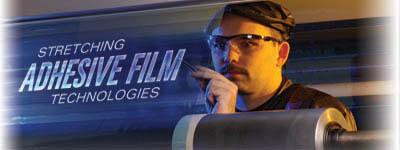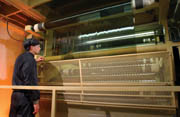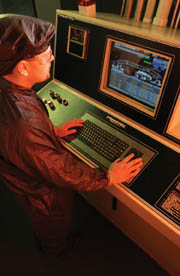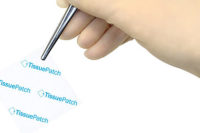
Watching a news broadcast on your widescreen TV set, you might be presented with an image of a NASA satellite covered by a protective drape, and later a rash of energetic cheerleaders rooting for their favorite sports team. Surprisingly, these widely different images - not to mention the very television set you're watching - might share one thing in common: products manufactured by CPFilms Inc., a division of Solutia Inc.
If you looked closely enough, you'd discover products made with precision-coated adhesive films, such as automotive decorative films, splicing tape and protective over-laminating films, are just about everywhere. But you probably wouldn't realize they're produced by CPFilms, and that's just fine with the company. Doug Goldstein, CPFilms' new business development manager, explains, "All relationships with our customers are strictly confidential, so nobody would know these products were actually coated or laminated by CPFilms."
The Precision Coated Films Division of this Martinsville, VA-based international manufacturer has been creating film solutions for a range of customers for close to 50 years. Goldstein reports that some customer relationships date back as far as 25 years.
"We've typically worked on many different projects for them over that time," he says. "But one thing always remains constant: the wealth of knowledge we provide about adhesive film technology and the best way to manufacture a product that meets demanding standards for durability and consistent quality. Our customers have access to resources that give them a lot of answers up front and help explore all the possibilities, thus saving time and expense in the R&D process."
The company of approximately 700 people is probably best known for producing solar-control films used in the residential, commercial and automotive retrofit markets. In fact, it describes itself as the world's largest converter of solar control window film and its various components. But CPFilms also enjoys a strong reputation for making the various components that go into the finished products of other converters, such as coated and metallized films. Supporting those endeavors is the company's wide-ranging converting technologies that include coating and laminating, vacuum metallizing, sputter coating, release coating, and deep dyeing.
The company's customer base includes many well-known players in the automotive and electronics markets, to name just a few. The confidential working relationships it builds with these firms means that CPFilms can work with competitors within the same industry niche.
"We've shown that we're able to manage those programs without sacrificing or compromising the confidentiality we've established with each of the companies," Goldstein says.

Superior Results Using Adhesive Films
According to Skip Cox, sales manager for vacuum coating, CPFilms not only provides toll-coating services for customers, but also offers valuable support when a customer needs more than an "obvious" solution. As an example, he describes one manufacturer of large-screen television systems that was facing a range of challenges."When you start making TV screens that are 42 inches or larger, you face all sorts of issues," he says. "The conventional-technology glass mirrors become extremely heavy. That requires designing more expensive cabinets, adds to your product shipping costs, and increases the incidence of breakage.
"Working with our customer, we were able to supply a metallized film for a solution that eliminates the need for a glass mirror, and also addresses corrosion control and life expectancy." According to Cox, the solution involves adhesive-bonding the metallized film in between two optically clear films. This laminated, thin-gauge film is then stretched over an aluminum frame. While being far lighter than conventional glass mirror technology, tests show that it is just as durable - and performs just as well - as glass. Coming up with the proper solution required humidity and salt fog testing to ensure that corrosion could be controlled and the TV image reflection would not be compromised.
Optically clear laminations represent a special capability that many other manufacturers can't offer. The company makes these products in a highly controlled cleanroom environment to ensure the highest degree of cross-web and run-to-run consistency.
"With optically clear products, you just can't cut corners on quality control," says Jay Hudson, precision coatings account manager. "Our customers come to us when they want clear and clean because they trust our expertise when it comes to clarity and cleanliness." This capability has enabled CPFilms to come up with applications for customers far beyond glassless mirrors and solar control window films to include liquid crystal displays, graphic arts, and numerous other possibilities.
Another recently developed and interesting coating and laminating application is the ability to laminate hard-coated films to steel. It's essentially a heat seal coated film with a hardcoat, bonded over steel to protect the surface from scratches and abrasion. In this case, the customer's application was for large kitchen appliances such as refrigerators and dishwashers. Sugar-laden products and aggressive liquids such as orange juice can be extremely caustic to painted steel, and applying CPFilms' product to the appliance surface protects against these types of hazards. According to David Newbitt, CPFilms' European marketing manager involved in the development of this product, a battery of tests was devised to ensure proper adhesion of the film to the steel.
"In addition to chemical testing, we conducted boiling water tests to determine temperature resistance, which is highly important for dishwashers and washing machines," he says.
Additional testing proved that the film adhesion performed extremely well where a corner might need to be formed out of the steel.
"The steel mill's spec required that our film follow the contours of the corner precisely, and we were able to meet that spec without a problem," Newbitt says.
He adds that successfully developing one product for a customer frequently opens the door to another new solution for a related application. In the case of the protective hardcoat film for steel, interest is now growing for a similar product that can be applied to stainless steel surfaces. "This product incorporates metal particles in the hard coat, and gives the user the ability to wipe down and sanitize surfaces easily and effectively in applications where cleanliness is important, especially in the foodservice and healthcare arenas," he says. "Also, the mill can apply this film coating to a lower grade of steel and provide the ‘look' of stainless, which increases the value-engineering options of the mill in dealing with certain customers."

Tackling the Technology
Doug Goldstein stresses the importance of CPFilms being able to offer a variety of technologies and manufacturing capabilities from one source. "One thing we offer that no one else in the industry does is five manufacturing technologies ‘all under one roof,' as the company promotes. Many of our customers find they'll need to access more than one of our capabilities to optimize their material structures. If they don't work with us, their alternative is to source materials and technical expertise from numerous different suppliers, adding time and cost to their project," he says. "We're able to perform complex jobs faster and more efficiently, particularly where a controlled production environment is needed."As an example, Goldstein cites the company's own line of Clearsil® release films for use with pressure-sensitive adhesives, which may be coated on the company's own metallized, deep-dyed or dyed metallized films.
To support its customers' varied needs, CPFilms operates four converting locations. In addition to its ISO 9001-certified, 400,000 sq. ft. headquarters facility in Martinsville, VA, other plants are located in Axton, VA; Canoga Park, CA; and Runcorn, UK. The Martinsville facility operates eight Faustel coating/laminating machines, while the UK facility houses three coater/laminators. In addition to supplying customers in North America and Europe, CPFilms exports products to South America and Asia. "We go where the action is, and for certain industries like electronics, that's often offshore," Goldstein says.
CPFilms' coating equipment can apply various coatings onto flexible films and other substrates - mostly polyester - or combine coated, metallized and/or dyed films into laminated structures. Solventborne, waterborne, and ultraviolet coatings can be applied in thicknesses from 0.012 to 75 microns and up to 74 inches in width. Substrates from suppliers such as DuPont Teijin Films, Mitsubishi Polyester Films, SKC Films and Toray Plastics range in thicknesses from 12 to 375 microns (0.5 to 15 mils).
The company's most recent acquisition of a 74-inch coater/laminator at the Martinsville plant contributed to 35% increased throughput, while reducing waste by approximately 30%. This equipment can apply hardcoats on one side of the film and pressure-sensitive adhesives on the opposite side - all in one pass. The unit, which also features an 80-foot drying oven, is made even more versatile due to its UV and thermal drying capabilities. While it was installed to handle the company's extensive window film business, the equipment also improves company capabilities in other product categories.
In addition to coating and laminating, the company offers sputter coating and vacuum metallizing at the same site. Thermal evaporation metallizers can apply a uniform deposition of aluminum onto clear and dyed transparent films to achieve anti-static, conductive and reflective properties. The company processes substrates ranging from 0.25 to 10 mils thick in widths to 80 inches.
According to Skip Cox, sputter coating - unlike conventional metallizing - allows the deposition of various types of metals, alloys and oxides, thereby providing flexible alternatives for customers involved in unique or more demanding applications. These coatings are applied to substrates with thicknesses ranging from 12 to 175 microns (0.5 to 15 mils), with metallizing deposits ranging from transparent to fully opaque, in widths to 80 inches.
Two other manufacturing technologies the company offers are employed to solve special customer challenges. The Clearsil product line encompasses film-based release liners featuring a variety of chemistries including tin and platinum-catalyzed silicones, UV-cured silicones, fluorosilicones, differential, and non-silicone release coatings. Various levels of release are achievable, ranging from "very easy" to "tight." Release liners are cleanroom-produced, thereby providing consistent-performing release properties. The company has numerous customers that serve the medical and electronics segments, where consistency and cleanliness are major requirements.
In addition, CPFilms has developed a patented process for colorizing film. This deep-dyeing process impregnates polyester films with colors and UV absorbers that the company claims will not flake, scratch, rub off, or streak. Using water- or solventborne processes, dyed films ranging from basic black to fluorescent colors (and even patterns) can be created with virtually no variation. Dyed films can also be metallized for use as a base for other processes, or for conveying a more reflective brilliance. Customer applications range from decorative laminates to theatrical lighting gels ... and yes, to cheerleader pom-poms.
One Source, Many Solutions
Over the years, CPFilms has helped literally hundreds of companies develop solutions to their manufacturing needs through the use of adhesive film technology. "Some of our customer relationships go back years - we've supported them on numerous different projects," Cox says.He believes that customers come to them for several reasons. "Typically, they have an idea that adhesive film technology would help them, but they don't have the technical knowledge to handle it themselves. They might not possess the proper equipment to make it themselves. Or, they may not have the production capacity and don't wish to take on additional capital investment."
How does CPFilms handle the developmental process? "The first thing we do is ask a lot of questions," says Cox. "We may include our R&D people as part of these discussions, because the challenges our customers face often don't have a simple, obvious solution. We explore what our customer needs to achieve, we review what's already been tried, and then we'll begin some testing using our customer's materials." He explains that the development process may take six months to a year or even longer, but taking the time to make sure the solution really works is crucial. "There's simply too much at stake to rush the process and end up with a design that doesn't meet the customer's requirements."
Cox recalled a recent situation with a customer who had a photovoltaic application for solar cells. "He had a substrate that needed metallic layers. First, we had to understand the makeup of the substrate. For the application to work, an opaque deposit of one particular metal along with a protective layer was required, and the frustrated customer had already tried a number of approaches that had failed completely. For a challenge like this, we need to move into our lab for trials." (Cox notes that CPFilms typically visits a customer's facility to gain a better understanding of the product and the manufacturing requirements.)
During the process of development and testing, a strong bond develops between CPFilms and customer personnel. "We end up learning a good deal about our customer's products and manufacturing activities, and they gain a strong resource for adhesive film technology," Goldstein says. "That serves both of us well on subsequent projects, where our understanding of their company puts us further along the learning curve. That's why we work with so many of the same customers year after year. Indeed, we can cite many cases where we've supported a customer through several different iterations of the same product, as their own products and technical requirements have evolved and become more complex over time," he concludes.
For more information about adhesive coating film technology and solutions, contact Doug Goldstein at (888) 273-4567 or (276) 627-3332, or visit http://www.cpfilms.com .
